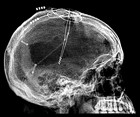
Undated x-ray shows electrode
implants in man's brain |
A team of American MDs has revived
a comatose patient using deep brain stimulation (DBS),
they report in the August 2 edition of Nature.
A few weeks ago, the 38-year-old Cleveland man, who'd
spent six years in a minimally-conscious state (MCS)
after being violently mugged, managed to recite the
first half of the Pledge of Allegiance.
A patient who's suffered traumatic
brain injury but occasionally responds to external cues
is classed as MCS. Rehab has shown limited success in
these patients, and their vegetative state was believed
to be permanent if there was no improvement within a
year or so. This case could change all that.
"This was a first," explains
study co-author Dr Kathleen Kalmar, chief neuropsychologist
at the JFK Medical Center Brain Trauma Unit in Edison,
NY. "DBS has been used in depression, obsessive-compulsive
disorder and very successfully in Parkinson's disease.
It took a very long time to get FDA approval," she adds.
FLICK
OF A SWITCH
"He was a typical MCS patient," says Dr Kalmar. "Some
days responding to questions and other days, nothing
at all. There's someone in there, but they won't come
out, to the great frustration of their families."
PET and fMRI suggested this patient's
MCS was due to a global reduction in brain activity
due to thalamic and midbrain disconnection and compression.
But in other ways, the patient was a good treatment
candidate. "We were looking for intact language regions,"
says Dr Kalmar, "and he showed potential. The thalamus
looked intact enough to support the use of the stimulator,
and the frontal region displayed some degree of function,
too."
The team induced brain activity
using acute DBS through bilateral electrodes implanted
in the central thalami. "The initial stimulation was
very brief, but the response was remarkable. He lifted
his arm, and verbalized a phrase his mother said he
often used," says Dr Kalmar.
The docs tried many different stimulation
frequencies, intensities, electrode contacts and on-off
periods. The patient's motor and vocalization ability
improved greatly during this time. The patient's limb
control and feeding got better too, and he began to
speak in a limited though intelligible manner. The researchers
concluded the effect was greater when the DBS machine
was on.
"My son, as well as the entire
family, had little hope of further recovery," said the
man's mother in a statement. "Now he can eat, express
himself and let us know if he is in pain. He can cry
and he can laugh and, most importantly, he can say,
'Mommy' and 'Pop' and he can say, 'I love you, Mommy'.
I still cry every time I see my son but it is tears
of joy."
Not all MCS patients possess the
necessary intact brain networks for DBS. The damage
in persistent vegetative states is often too great for
any hope of reawakening. But DBS may one day be an option
in some MCS patients who'd be otherwise lost forever.
"It's very exciting doing this kind of research and
working with this patient," says Dr Kalmar. "Hopefully
it's the start of something big."
|